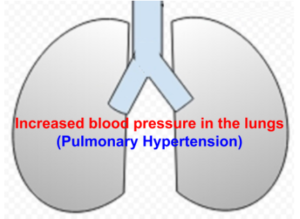What is pulmonary hypertension?
What is pulmonary hypertension?
Pulmonary hypertension is increase in the blood pressure in blood vessels taking deoxygenated (containing less of oxygen) blood to the lungs for oxygenation (‘filling up with oxygen’). Normally the blood pressure in the blood vessels of the lungs is much lower compared to that in the rest of the body. Blood for oxygenation received from the body is pumped into the lungs by the right ventricle (right lower chamber of the heart). Since the blood pressure in this system is low, right ventricle is a thin walled (less muscular) chamber compared to the much thicker and muscular left ventricle (left lower chamber of the heart). When the blood pressure in the lungs rises, the right ventricle finds it more and more difficult to pump blood. This is initially overcome by increase in the muscle thickness of the right ventricle (right ventricular hypertrophy). If the pulmonary hypertension goes beyond a certain limit, the right ventricle fails. When the right ventricle fails, blood dams up in the veins (blood vessel carrying deoxygenated blood) of the body. This in turn leads to retention of fluid in various parts of the body (edema), which can manifest as puffiness of face and ankle swelling.
In other situations, when the right ventricle cannot pump enough blood to the lungs, blood returning to the left side of the heart from the lungs for pumping back to the rest of the body decreases. This can cause dizziness on exertion as the blood flow cannot match the increased need of the muscles during walking. Consequently blood pressure in the vessels of the body (arteries) may fall and brain receives less of blood, causing dizziness.



